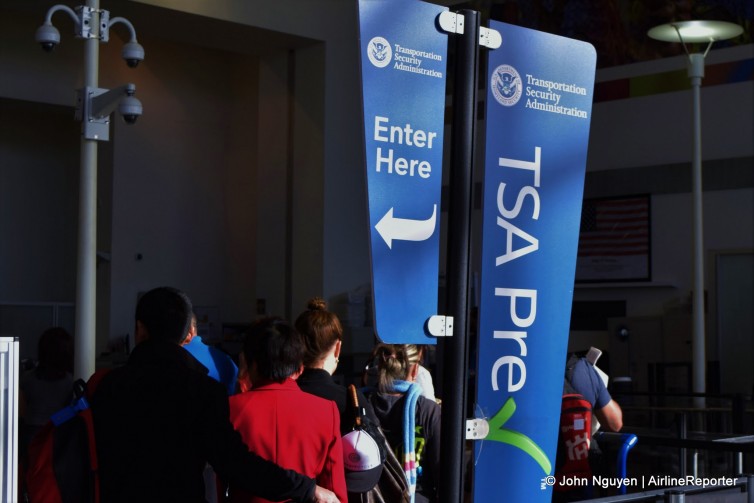
The TSA PreCheck area at LAX Terminal 2
Let’s make one thing clear: TSA PreCheck is great. If you’ve flown anytime in the past few years, you’ve seen (or perhaps even been the beneficiaries of) the “PreCheck” lanes that some passengers use to zip past the general security lines, or even the premium lanes. Those who see others scoot all the way out of sight and/or get to keep their shoes on are envious; those who randomly received PreCheck access once are even more so.
For the low low price of $85, the Transportation Security Administration will grant a passenger the privilege of getting PreCheck most (not all) of the time. They’re in charge of keeping the flying public safe, and they’re not a for-profit institution, so we can trust them at their word, right?
NO! What they don’t tell you is that there are other ways to enroll in TSA’s PreCheck program without a) writing a check to TSA and b) paying less, or at least getting more out of what you pay.
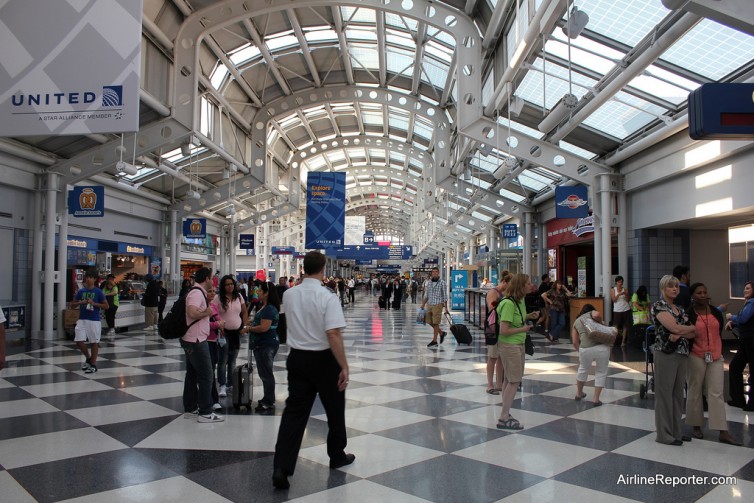
You want to be safe past security, right?
PreCheck is administered by the TSA, but what most of the public doesn’t realize (and the TSA doesn’t call attention to) is that TSA isn’t the only agency that can enroll passengers into PreCheck. Under the umbrella of “trusted traveler” programs, two other types of enrollment yield better return on value, either by costing less or providing more. Here’s the low-down…
What is PreCheck?
From the TSA itself: “TSA Pre✓® is an expedited security screening program connecting travelers departing from the United States with smarter security and a better air travel experience. Passengers considered low-risk who qualify for the program can receive expedited screening either as a member of the program or another specific trusted traveler group.”
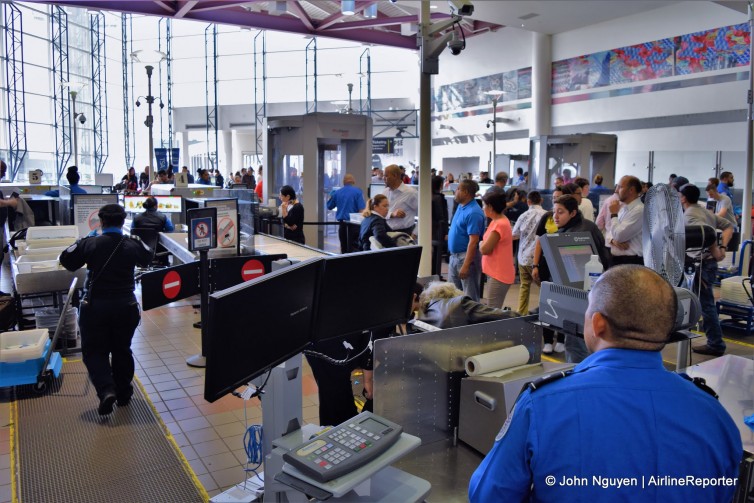
A busy afternoon at the security checkpoint at LAX’s Terminal 2
In summary, the subject passenger submits to a background check, and if that clears, the passenger gets to use special marked lanes at airport security, leave their shoes and light jackets on, keep their laptops and liquids in their bags, and avoid the dreaded millimeter wave scanner. In my experience, when everything goes according to plan, I usually clear security in two to five minutes – from entering the security line to walking away airside. The cost to apply is $85; it’s worth noting that a passenger who fails their background check and is denied enrollment loses that application fee.
Once a passenger is approved, they are given a Known Traveler Number (KTN) that can be entered when making air reservations.
Of course, there are certain restrictions in place:
- You must be a U.S. citizen or permanent resident, or enrolled in Global Entry (more on that later);
- The airport you’re flying from must have PreCheck facilities;
- The airline you’re flying with must participate in the PreCheck program;
- You’re not guaranteed to have PreCheck all the time;
- The PreCheck lane may not be open at all times of the day, and may close at random times;
- You may be randomly selected for full inspection anyway.
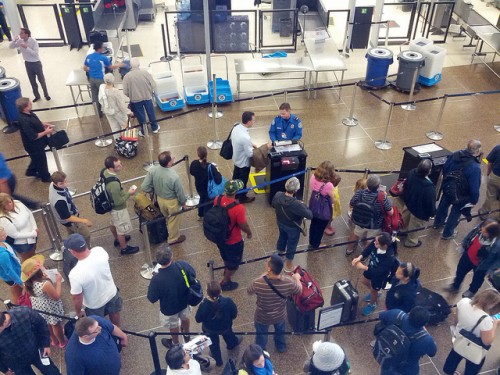
Security at SEA – Photo: Andrew Pilloud | Flickr CC
On top of all that, some non-PreCheck-enrolled passengers may receive PreCheck anyway. The TSA was criticized heavily last year for their use of “managed inclusion” that sent countless passengers, many of them unsuspecting, through PreCheck. It caused slowdowns and logjams from confused people used to normal security procedures, blocking passengers who paid the fee to enroll in PreCheck. Managed inclusion has since ended (supposedly), but regular passengers are still being randomly selected for PreCheck.
The Shakedown: TSA sells their trust for $85
The arguments are convincing; For $85, you get PreCheck for the next five years. If you spread that out, that’s only $17 per year, or $1.42 per month, or $0.05 per day, or less than a penny per hour (you get my point). I’m sure many folks are convinced that it’s a low price to pay to avoid the hassle that the TSA itself created for the convenience, and I would tend to agree, especially if you fly more than a couple of times a year.
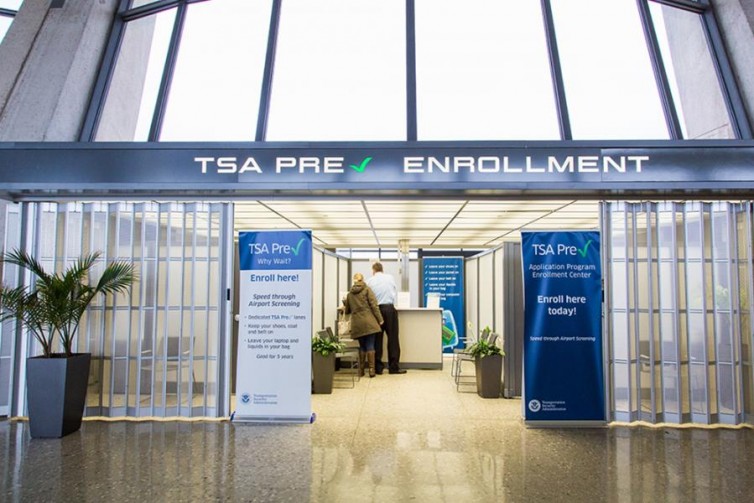
Photo: Department of Homeland Security
To enroll in PreCheck, applicants visit an enrollment center, which many airports have. You can submit your application online or in-person, but it’s relatively quick, especially if you book an appointment. Walk-ins are usually accepted.
And enrolled they did; as of mid-January, the TSA reported that over 2 million people had signed up, gaining 500,000 new signups since last August. While there was some promotion via social media ads and displays at the airports, the TSA took a page right out of a drug dealer’s playbook: They offered up free samples (remember those regular passengers who randomly got selected?) to get passengers hooked. Seeing an empty line while standing in a long one probably helped too. Pretty conniving.
Super-Size Me: Global Entry
Global Entry is different trusted travel program that’s administered by the US Customs and Border Protection (CBP) agency, and allows for expedited entry when you arrive from overseas. At most U.S. airports with international flights, and major land crossings, there are special lanes and kiosks just for Global Entry holders.

An arriving passenger at Newark Liberty International Airport (EWR) uses a Global Entry kiosk – Photo: Josh Denmark | US CBP
I signed up for Global Entry in 2013, and it was a relatively painless process that involved a five-minute interview at the CBP office at Los Angeles International Airport, inside the international terminal. After reviewing my application and confirming where I was born, my application was approved in the system. From then on, my Global Entry enrollment would be recognized simply by scanning my passport at a special kiosk, which also takes fingerprints and a photo.
I set my personal speed record on my first use, which also happened to be at LAX, notoriously crowded at times before its recent renovation. From stepping off the plane to arriving on the curb, it took me only 12 minutes, and the majority of that time was spent waiting for my bags to arrive at the carousel. On subsequent arrivals, I average 15-20 minutes, with virtually no wait at the Global Entry kiosks, bypassing passport check lines that often wrapped several times.
The (small) catch to Global Entry is that it costs $100, but is also valid for five years, and the kicker is that it includes automatic participation in PreCheck. Applicants also have to schedule an interview online at a CBP office, which could sometimes take a few weeks or months. Appointments often open up due to cancellations, and some offices allow for walk-in interviews for those who have pending applicaitons. To me, even coming home from abroad just once or twice during those five years is worth the slight extra effort and $15 premium over just paying for PreCheck by itself.
On a Shoestring: NEXUS
Some of you driving to or from Canada may have noticed special traffic lanes marked “NEXUS.” For those who are lucky enough to live near the U.S.-Canadian border, or will be passing through, there’s another trusted traveler program available called NEXUS, which is jointly operated by CBP and the Canada Border Services Agency (CBSA). It’s similar to Global Entry in that it allows for quicker international crossings, but NEXUS has the added benefit of allowing expedited screenings into Canada as well as the United States.

The U.S.-Canada border crossing in Blaine, WA. Note the NEXUS traffic lane on the far right. – Photo: Wikimedia Commons
What’s REALLY fun about NEXUS is that it not only includes PreCheck, but also Global Entry and expedited access to Mexico via SENTRI (see below), all for a fee of…
$50.
$50!
What’s the catch? The big hurdle is that applicants must be interviewed at facilities that have both CBP and CBSA agents, and those are mainly the U.S.-Canada border crossings. Some exceptions exist farther inland, such as the CBP offices at King County Airport/Boeing Field in Seattle. The other hurdle is that readily-available appointment times are usually a few months away.
But if you happen to be (or will be) near the border, and are not in a rush, NEXUS is the best value available to become a trusted traveler.
It’s also worth noting that there’s another program called SENTRI that replicates NEXUS but on the U.S.-Mexico border. While it costs the most at $125, some travelers may find the cost worth it, especially in not having to incur the extra travel north. SENTRI is also reciprocal with NEXUS.
In summary…
| Trust Traveler Program | PreCheck | Global Entry | NEXUS |
| Cost | $85 | $100 | $50 |
| Difficulty in scheduling interview | Easy | Mildly difficult | Most difficult |
| PreCheck for domestic departures |
✓ | ✓ | ✓ |
| Expedited Entry into US | ✓ | ✓ | |
| Expedited Entry into Canada | ✓ |
No doubt, PreCheck makes the most annoying part of air travel almost civilized again. But in my opinion, it’s a complete folly to fall for TSA’s enrollment, since you only get one aspect of the trusted travel programs for a comparatively too-high price. Most passengers are better off signing up for Global Entry or NEXUS.
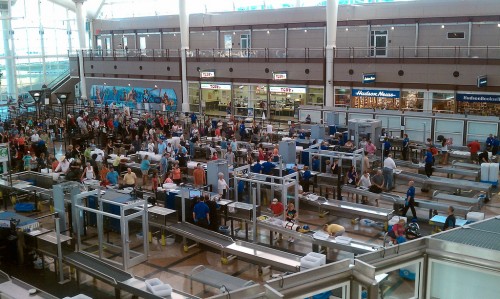
Long security lines at Denver International Airport – Photo: Quinn Dombrowski | Flickr CC
This is a little over the top “THE SHAKEDOWN: TSA SELLS THEIR TRUST FOR $85”.
You do still have to pass the background check and I do know someone who did not get Global Entry because of a failed background check. So I would say the system works.
You are paying for the background check, it is not really a shakedown.
The point I was trying to make is that the same background check the TSA charges $85 for is the same as what CBP charges $100 (GE) or $50 (NEXUS) for. I personally would know how TSA came up with that $85 figure. Either way, it’s hard for me to come up with a reason to justify anyone, who has all the pertinent information, going directly to signup for just TSA PreCheck when they have other options available.
John | AirlineReporter
Hey DK,
Obviously there are going to be costs associated with the program. However, I know when I need to do background checks for new apartments, it is closer to $25 than $85. I would imagine that the government can do it a bit cheaper.
David | AirlineReporter
Nexus also gives you expedited access through Canadian airports, along with airline crews…I love mine and will always have one!
+1. I’m signed up for Global Entry now, but when that’s up for renewal, I’m going to sign up for NEXUS.
John | AirlineReporter
Nexus checks you through FBI, Royal Canadian Mounted Police, Interpol as well as does fingerprints and retinal scans. I fly a lot and can’t think of anyone I would rather sit beside…
You are correct, thanks for clarifying. Additional checks because the Canadian authorities are also involved. I have no worries about passing the those checks 🙂
My wife has NEXUS, and it was an easy process for her, with less than 5 minutes each with a CBP officer, then CBSA. No retinal scans yet, since she applied at King County/Boeing Field, but those are taken at the border stations. Her GE and PreCheck statuses are active, however.
John | AirlineReporter
Agree, John.
Great.
I have NEXUS, and its worth every penny. I’m lucky to live in Seattle, so driving up to Blaine was worth it. A few notes about NEXUS though.
To use it for expedited immigration at Canadian airports you need to get retina scans (available at any Canadian NEXUS enrollment center).
For a NEXUS interview, BFI is the most convenient location, but also has the fewest interview slots by far. Blaine and YVR have many more slots.
Once you’ve decided on which social media networks you
want to focus on, begin creating a plan and gather more data about that social media network and the fans you have on it, then work on growing the page.
May they be small businesses or established organizations, all can really benefit from the dynamism, versatility, and efficiency that this world recognized social
networking site can offer. Vine’s addictive platform led to a Facebook page dedicated to the best Vines out there getting
3 million likes in just three weeks’ time.
our even NOT be longer and harder still up for the very low thanks for the post
Very good and enlightening this article John, helped me a lot, thank you.
Hello John I also fully agree with your article congratulations.
Surely precheck is a great alternative for those who want and need to pay less, I’m using it frequently.
I am completely in favor of the pre check in airports, I believe this can yes streamline and much.